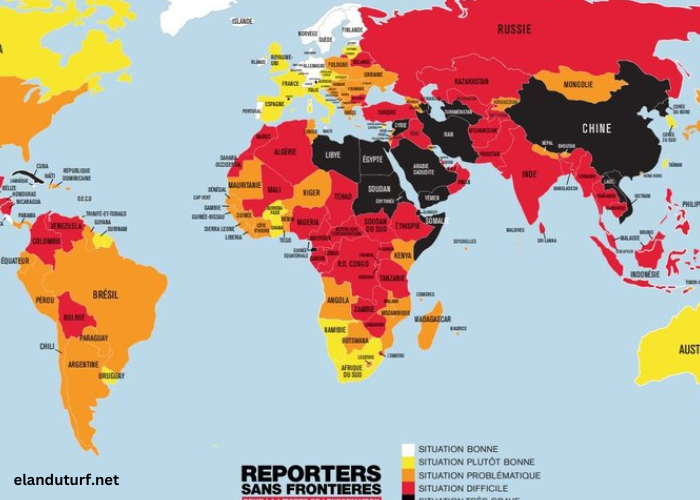In an age where information is constantly at our fingertips, understanding the sources of that information is crucial. The Classement DE LA Presse plays a significant role in how media outlets are perceived and how they rank among their peers. This ranking system not only affects the reputation of various publications but also influences advertising revenue, reader trust, and the overall landscape of media consumption.
In this article, we will delve into the concept of Classement DE LA Presse, examining its importance, the criteria used for rankings, the implications for journalists and readers, and how this ranking system can evolve in the digital age. Whether you are a media professional, a curious reader, or simply interested in the dynamics of information dissemination, this guide will provide you with a comprehensive understanding of Classement DE LA Presse.
What is Classement DE LA Presse?
Classement DE LA Presse refers to the ranking of media outlets based on various criteria, including readership, credibility, and influence. This ranking system helps readers navigate the vast landscape of information available and can significantly impact the visibility and credibility of different publications.
Typically, these rankings are compiled by organizations that analyze a variety of factors, such as circulation figures, online engagement metrics, and the quality of journalism produced. The ultimate goal is to provide a clear picture of which outlets are leading the pack in terms of trustworthiness and reach.
This ranking is particularly relevant in a time when misinformation is rampant, and readers must be discerning about where they get their news. By understanding the Classement DE LA Presse, consumers can make more informed choices about the sources they rely on for information.
Why is Classement DE LA Presse Important?
The importance of Classement DE LA Presse extends beyond mere numbers. It holds significant implications for both media outlets and consumers. For media organizations, a higher ranking often correlates with increased advertising revenue and greater market influence. Advertisers tend to favor publications with a strong reputation, leading to more lucrative partnerships.
From the consumer perspective, the rankings serve as a guideline for quality. When readers see a publication ranked highly in the Classement DE LA Presse, they may feel more inclined to trust the information presented. This trust is crucial in fostering a well-informed public, particularly in an era where misleading information can spread quickly.
Moreover, Classement DE LA Presse can incentivize media outlets to uphold high journalistic standards. The competitive nature of rankings can push publications to focus on accuracy, thoroughness, and ethical reporting. As a result, the overall quality of journalism may improve, benefiting society as a whole.
How is Classement DE LA Presse Determined?
The methodology behind Classement DE LA Presse can vary depending on the organization compiling the rankings. However, several common criteria are generally considered.
First and foremost, readership numbers are crucial. This includes print circulation as well as digital engagement metrics, such as website traffic and social media interactions. A publication that is widely read is likely to rank higher, as it indicates a larger audience and greater influence.
Another key factor is the credibility and quality of journalism. This is often assessed through evaluations of journalistic practices, the accuracy of reported information, and the outlet’s history of ethical reporting. Publications that prioritize fact-checking and responsible journalism tend to fare better in the rankings.
Additionally, external factors such as audience demographics and geographic reach can play a role in the Classement DE LA Presse. For example, a publication that caters to a specific demographic might be ranked lower if it has a smaller overall readership compared to a more generalist outlet.
What are the Implications of Classement DE LA Presse for Media Outlets?
For media outlets, the implications of Classement DE LA Presse are significant. A high ranking can enhance credibility, attracting both readers and advertisers. Publications that consistently rank well may find themselves in a position to negotiate better advertising rates and partnerships, thereby boosting their financial health.
Conversely, a poor ranking can have detrimental effects. Media outlets that are perceived as less credible may struggle to attract readers and advertisers alike. This can create a vicious cycle: declining readership leads to reduced revenue, which in turn may force outlets to cut costs, often resulting in a decline in journalistic quality.
Moreover, rankings can influence editorial choices. Outlets may feel pressure to sensationalize stories or prioritize clickbait headlines to improve their rankings. This shift in focus can have serious consequences for the quality of journalism, as the pursuit of higher rankings might overshadow the commitment to delivering accurate and meaningful news.
How Does Classement DE LA Presse Affect Reader Trust?
Reader trust is a vital component of the media landscape, and Classement DE LA Presse plays a crucial role in shaping it. When readers see consistent rankings of certain outlets, they may develop a sense of trust based on the perceived credibility of those publications.
However, the relationship between rankings and trust is complex. A high ranking does not automatically equate to trustworthy reporting. Readers must remain discerning, as some outlets may prioritize ranking over journalistic integrity. This is where critical media literacy comes into play; readers should question the sources of their information, regardless of rankings.
In this context, Classement DE LA Presse serves as both a guide and a cautionary tale. While it can help readers identify reputable sources, it is essential for consumers to approach rankings with a critical mindset, ensuring they are not swayed solely by numbers.
How Does Digital Transformation Impact Classement DE LA Presse?
As the media landscape continues to evolve, digital transformation plays a crucial role in shaping Classement DE LA Presse. The rise of online news platforms, social media, and user-generated content has introduced new dynamics that impact how rankings are determined and perceived.
One significant effect of digital transformation is the changing metrics used to evaluate media outlets. Traditional measures like print circulation are now supplemented with digital engagement metrics, such as website traffic, social shares, and comments. This shift has led to a more comprehensive understanding of audience engagement but also raises questions about the quality of engagement.
Furthermore, social media platforms have become powerful players in determining which outlets gain visibility. Publications that successfully leverage social media may see their rankings improve due to increased traffic and engagement. However, this reliance on social media can also lead to challenges, as the algorithms governing these platforms often prioritize sensational or clickbait content over in-depth reporting.
The digital landscape also opens the door for alternative rankings and evaluation methods. As audiences become more aware of media bias and misinformation, there is a growing demand for transparent metrics that reflect journalistic quality and ethical practices. This trend could lead to the emergence of new organizations dedicated to providing more nuanced evaluations of media outlets, shaping the future of Classement DE LA Presse.
What are the Challenges Facing Classement DE LA Presse?
Despite its significance, Classement DE LA Presse is not without challenges. One major issue is the potential for bias in rankings. If the organizations compiling the rankings have their own agendas or biases, the results may not accurately reflect the true standing of media outlets. This can lead to misrepresentation and confusion among readers.
Another challenge is the rapidly changing media landscape itself. As new platforms emerge and consumption habits shift, the criteria for rankings may struggle to keep pace. This can create inconsistencies in how outlets are evaluated, leading to frustration among both media organizations and consumers.
Moreover, the pressure to rank well can compromise journalistic integrity. Outlets may feel compelled to cater to ranking systems, prioritizing content that drives traffic rather than focusing on quality reporting. This shift can dilute the essence of journalism, undermining the very purpose of media as a watchdog of society.
Conclusion
In summary, Classement DE LA Presse is a crucial aspect of the modern media landscape, influencing how readers perceive and interact with information. Understanding the factors that contribute to these rankings and their implications for media outlets is essential for both consumers and professionals in the industry.
While the rankings can serve as valuable tools for navigating the vast array of media options available, they also come with challenges and limitations. As digital transformation continues to reshape the way we consume news, the future of Classement DE LA Presse will likely evolve, necessitating a critical approach from readers and a commitment to maintaining journalistic integrity from media organizations.
By fostering awareness and critical thinking, we can navigate the complexities of the media landscape and promote a more informed and engaged public. Ultimately, the success of Classement DE LA Presse hinges on our ability to balance the influence of rankings with the pursuit of high-quality journalism.




